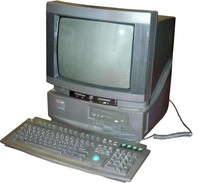|
ICL Plc announced the PCTV - a fully configured multimedia personal computer and television set with 14 screen and Nicam stereo combined in a single unit, and the Indiana multimedia home computer range, each in a charcoal coloured casing. Both ranges carry the new Fujitsu ICL badge. The television device is 80486DX/66-based.
Chairman Peter Bonfield said ICL is not planning to rebadge its mainframe products, nor will it drop the ICL from the Fujitsu ICL badge.
Processor 486DX2
Chip set Via VT82c486a 80486 PC/AT
External speed 33 MHz
cache 8 Kilobytes internal cache L1 256 kilobytes External cache L2
Video controller Vesa Local Bus, based on Cirrus GD5428 with 1mb of video RAM
RAM 4 to 64 megabytes
Serial ports Male 9-pin and 25-pin D-type, RS232 compatible
Parallel port Femal 25-pin D-type, Centronics compatible
Keyboard socket Female 6-pin miniature DIN, PS/2 compatible
Headphone socket, 3.5mm mini-jack, Joystick/MIDI socket, 15 pin D-type,
Conforms to the MPC2 standard Sound Blaster conformant built-in audio
Dimensions Width 388 mm, Height 440 mm, Depth 446 mm
Weight 25 kilograms
This unit was sold through the Toy & Electronics retailer Toys R Us
Our machine was very kindly donated by Chris Hankin
Documents included with the computer include:
ICL Technical Journal Volume 1 Issue 2 May1979
ICL Technical Journal Volume 1 Issue 3 November1979
Goldrush Mega Server Technical Overview Rerf: B93/307
An advanced concept in distributed processing
DAP Fortran Language Reference
VME/K to VME 2900 Planning Guide
ICL Series 39 corporate systems information pack
ICL 1900 series Plan Reference Manual Ref: 4322 (7.72) 200 pages
ICL 1900 Series direct access for 1900 COBOL Programmers (Course Training Manual REf: 5626 1st Edition May 1980
ICL Personal Computer concurrent CP/M - 86 Operating System, User's Guide Ref: R103200 1984
ICL Personal Computer concurrent CP/M - 86 Programmer's Utility Guide Ref: 10327/00 1984
Manufacturer: ICL
Date: March 1995
Comment on This Page
Other Systems Related To ICL Fujitsu PCTV:
This exhibit has a reference ID of CH22036. Please quote this reference ID in any communication with the Centre for Computing History.
|











